The Intel Broadwell Desktop Review: Core i7-5775C and Core i5-5675C Tested (Part 1)
by Ian Cutress on June 2, 2015 7:45 AM ESTProfessional Performance: Linux
Built around several freely available benchmarks for Linux, Linux-Bench is a project spearheaded by Patrick at ServeTheHome to streamline about a dozen of these tests in a single neat package run via a set of three commands using an Ubuntu 11.04 LiveCD. These tests include fluid dynamics used by NASA, ray-tracing, OpenSSL, molecular modeling, and a scalable data structure server for web deployments. We run Linux-Bench and have chosen to report a select few of the tests that rely on CPU and DRAM speed.
Due to our limited testing time and other issues, only the i7-5775C was processed in our Linux tests. These should be updated for Part 2.
C-Ray: link
C-Ray is a simple ray-tracing program that focuses almost exclusively on processor performance rather than DRAM access. The test in Linux-Bench renders a heavy complex scene offering a large scalable scenario.
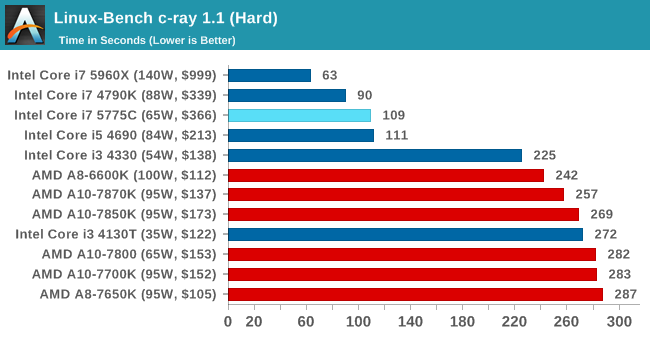
NAMD, Scalable Molecular Dynamics: link
Developed by the Theoretical and Computational Biophysics Group at the University of Illinois at Urbana-Champaign, NAMD is a set of parallel molecular dynamics codes for extreme parallelization up to and beyond 200,000 cores. The reference paper detailing NAMD has over 4000 citations, and our testing runs a small simulation where the calculation steps per unit time is the output vector.
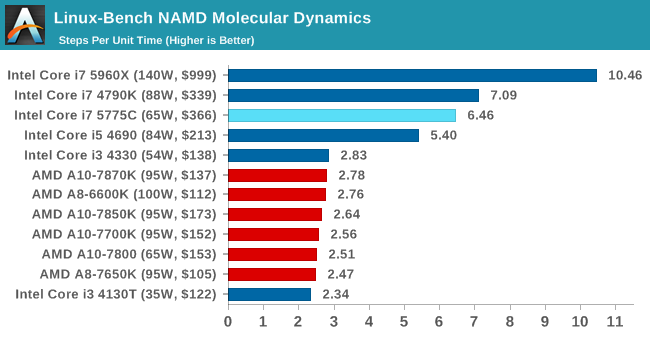
NPB, Fluid Dynamics: link
Aside from LINPACK, there are many other ways to benchmark supercomputers in terms of how effective they are for various types of mathematical processes. The NAS Parallel Benchmarks (NPB) are a set of small programs originally designed for NASA to test their supercomputers in terms of fluid dynamics simulations, useful for airflow reactions and design.
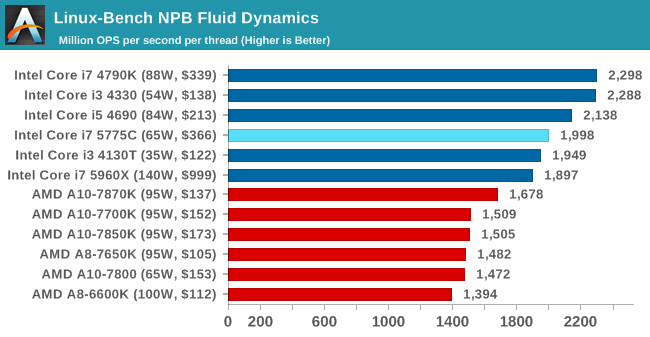
Redis: link
Many of the online applications rely on key-value caches and data structure servers to operate. Redis is an open-source, scalable web technology with a b developer base, but also relies heavily on memory bandwidth as well as CPU performance.
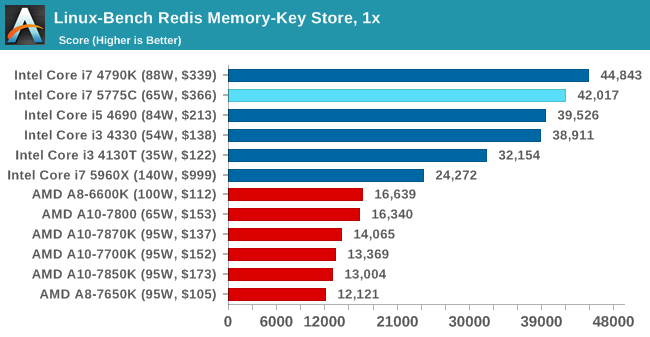
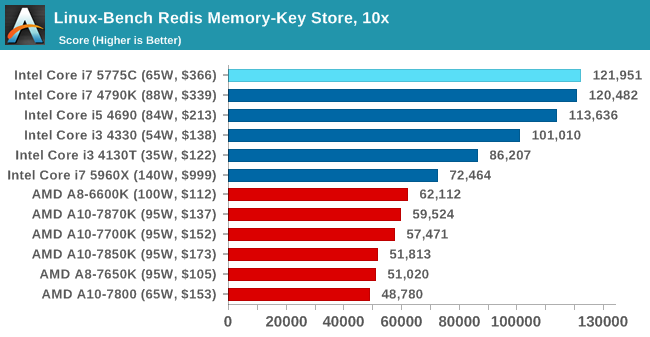
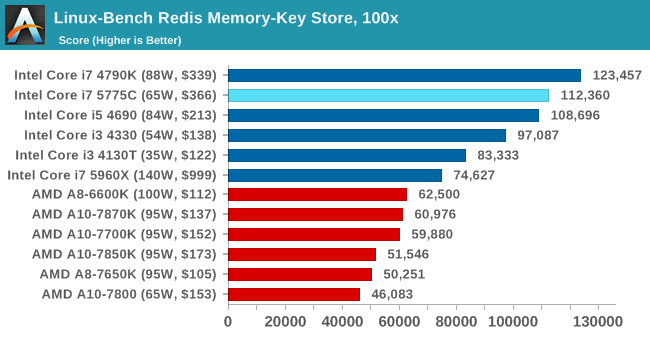










196 Comments
View All Comments
extide - Tuesday, June 2, 2015 - link
Have you ever overclocked a CPU before? Those limits are easily raised, and a properly O/C'd build will not throttle...DCide - Tuesday, June 2, 2015 - link
It's hardly elite - just live video. But if the CPU saturates or crashes, everybody will know.I'm not skilled at overclocking. But for this application, stability is paramount. I wouldn't want to push it close to the limit, only to have it crash 5 hours into the stream. When I tested 4-core CPUs I had to run at low resolutions, or else the video would stutter. And I even at that I couldn't use all the features of the application.
With the same low-profile case and the same heatsink/fan the 4790K would throttle in less than 30 minutes while the 5820K and 5960X never would. They were all running at 4GHz. I'm sure someone more skilled could make all 3 CPUs run faster. But the 8-core is still going to be about twice as fast as the 4-core.
On the topic of the new CPUs, I won't be surprised if they O/C well enough to make them dominate the previous generations. But they won't be a match for the 2011-3 CPUs.
vision33r - Tuesday, June 2, 2015 - link
If you're into server workloads, 8 cores would nice. For gaming, more cores only adds more heat and hardly any benefit to gaming performance. For gaming, quad-core is good enough with no integrated GPU. All this integrated GPU stuff is just a waste of resources. Most of us into performance and gaming don't want the extra heat and power consumption.FlushedBubblyJock - Sunday, June 14, 2015 - link
If the kiddies can play WoW on it, amd and intel are happy. They will never stop.Galatian - Tuesday, June 2, 2015 - link
Would like to see some Quicksync Benchmarks! Anand noted fast Quicksync performance on the Iris Pro 5200, so I sure would like to see a) the differences between GT3e (Haswell) and GT3e (Broadwell) and b) the differences between GT2 (Haswell) and GT3e (Broadwell).Refuge - Tuesday, June 2, 2015 - link
I think that is coming in part 2 judging by the first two pages of the article.Kevin G - Tuesday, June 2, 2015 - link
I'll second the request for QuickSync testing. I do a bit of video editing with Vegas and do some bulk conversions with Handbrake so I have a keen interest on this topic.dj_aris - Tuesday, June 2, 2015 - link
I'd like to see the 65w 4770R in the charts to measure the delta over a a generation (okay half a generation). Meanwhile, considering that i5-5675C is $276 but games much worse than a Haswell Pentium + a decent $200 discrete card I really don't see the point in traditional desktops. The only scenario I see fit would be in a tiny case using a super low profile thin mini-ITX board, so as to create a system similar to, say, an Alienware Alpha. But wait, there aren't any thin mini-ITX H or Z97 boards. Whereas back with Haswell we had thin mini boards but only non-Iris iGPUs. Oh Intel, there's always a part missing!DCide - Tuesday, June 2, 2015 - link
I think you mean you don't see the point for a gaming desktop. A Pentium + $200 dGPU would be a poor choice for most traditional desktops.Mech0z - Tuesday, June 2, 2015 - link
With DX12 supporting multiGPU much much better, could it be theorized that these will be very good for DX12 games together with a dGPU?